NISSAN QASHQAI 2014 Owner´s Manual
Manufacturer: NISSAN, Model Year: 2014, Model line: QASHQAI, Model: NISSAN QASHQAI 2014Pages: 338, PDF Size: 4.87 MB
Page 51 of 338
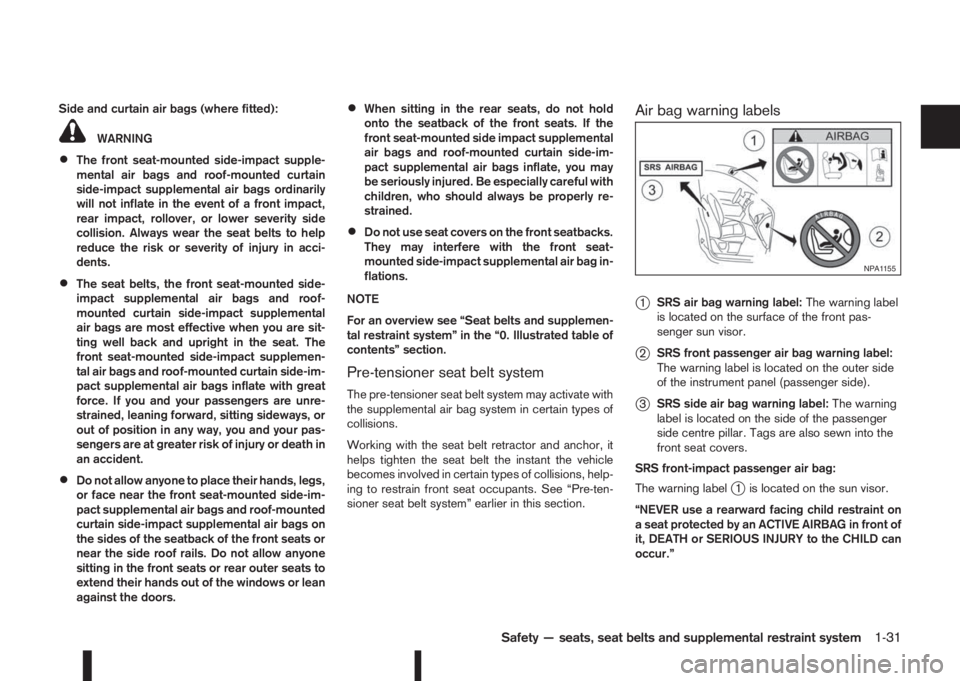
Side and curtain air bags (where fitted):
WARNING
•The front seat-mounted side-impact supple-
mental air bags and roof-mounted curtain
side-impact supplemental air bags ordinarily
will not inflate in the event of a front impact,
rear impact, rollover, or lower severity side
collision. Always wear the seat belts to help
reduce the risk or severity of injury in acci-
dents.
•The seat belts, the front seat-mounted side-
impact supplemental air bags and roof-
mounted curtain side-impact supplemental
air bags are most effective when you are sit-
ting well back and upright in the seat. The
front seat-mounted side-impact supplemen-
tal air bags and roof-mounted curtain side-im-
pact supplemental air bags inflate with great
force. If you and your passengers are unre-
strained, leaning forward, sitting sideways, or
out of position in any way, you and your pas-
sengers are at greater risk of injury or death in
an accident.
•Do not allow anyone to place their hands, legs,
or face near the front seat-mounted side-im-
pact supplemental air bags and roof-mounted
curtain side-impact supplemental air bags on
the sides of the seatback of the front seats or
near the side roof rails. Do not allow anyone
sitting in the front seats or rear outer seats to
extend their hands out of the windows or lean
against the doors.
•When sitting in the rear seats, do not hold
onto the seatback of the front seats. If the
front seat-mounted side impact supplemental
air bags and roof-mounted curtain side-im-
pact supplemental air bags inflate, you may
be seriously injured. Be especially careful with
children, who should always be properly re-
strained.
•Do not use seat covers on the front seatbacks.
They may interfere with the front seat-
mounted side-impact supplemental air bag in-
flations.
NOTE
For an overview see “Seat belts and supplemen-
tal restraint system” in the “0. Illustrated table of
contents” section.
Pre-tensioner seat belt system
The pre-tensioner seat belt system may activate with
the supplemental air bag system in certain types of
collisions.
Working with the seat belt retractor and anchor, it
helps tighten the seat belt the instant the vehicle
becomes involved in certain types of collisions, help-
ing to restrain front seat occupants. See “Pre-ten-
sioner seat belt system” earlier in this section.
Air bag warning labels
j
1SRS air bag warning label:The warning label
is located on the surface of the front pas-
senger sun visor.
j2SRS front passenger air bag warning label:
The warning label is located on the outer side
of the instrument panel (passenger side).
j3SRS side air bag warning label:The warning
label is located on the side of the passenger
side centre pillar. Tags are also sewn into the
front seat covers.
SRS front-impact passenger air bag:
The warning label
j1 is located on the sun visor.
“NEVER use a rearward facing child restraint on
a seat protected by an ACTIVE AIRBAG in front of
it, DEATH or SERIOUS INJURY to the CHILD can
occur.”
NPA1155
Safety — seats, seat belts and supplemental restraint system1-31
Page 52 of 338
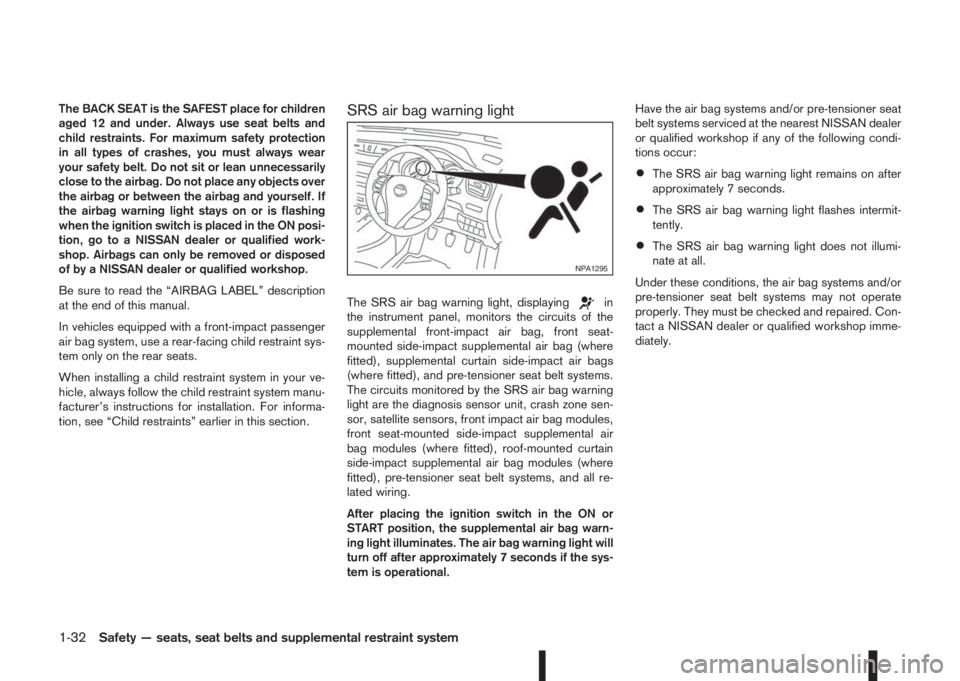
The BACK SEAT is the SAFEST place for children
aged 12 and under. Always use seat belts and
child restraints. For maximum safety protection
in all types of crashes, you must always wear
your safety belt. Do not sit or lean unnecessarily
close to the airbag. Do not place any objects over
the airbag or between the airbag and yourself. If
the airbag warning light stays on or is flashing
when the ignition switch is placed in the ON posi-
tion, go to a NISSAN dealer or qualified work-
shop. Airbags can only be removed or disposed
of by a NISSAN dealer or qualified workshop.
Be sure to read the “AIRBAG LABEL” description
at the end of this manual.
In vehicles equipped with a front-impact passenger
air bag system, use a rear-facing child restraint sys-
tem only on the rear seats.
When installing a child restraint system in your ve-
hicle, always follow the child restraint system manu-
facturer’s instructions for installation. For informa-
tion, see “Child restraints” earlier in this section.SRS air bag warning light
The SRS air bag warning light, displayingin
the instrument panel, monitors the circuits of the
supplemental front-impact air bag, front seat-
mounted side-impact supplemental air bag (where
fitted), supplemental curtain side-impact air bags
(where fitted), and pre-tensioner seat belt systems.
The circuits monitored by the SRS air bag warning
light are the diagnosis sensor unit, crash zone sen-
sor, satellite sensors, front impact air bag modules,
front seat-mounted side-impact supplemental air
bag modules (where fitted), roof-mounted curtain
side-impact supplemental air bag modules (where
fitted), pre-tensioner seat belt systems, and all re-
lated wiring.
After placing the ignition switch in the ON or
START position, the supplemental air bag warn-
ing light illuminates. The air bag warning light will
turn off after approximately 7 seconds if the sys-
tem is operational.Have the air bag systems and/or pre-tensioner seat
belt systems serviced at the nearest NISSAN dealer
or qualified workshop if any of the following condi-
tions occur:
•The SRS air bag warning light remains on after
approximately 7 seconds.
•The SRS air bag warning light flashes intermit-
tently.
•The SRS air bag warning light does not illumi-
nate at all.
Under these conditions, the air bag systems and/or
pre-tensioner seat belt systems may not operate
properly. They must be checked and repaired. Con-
tact a NISSAN dealer or qualified workshop imme-
diately.
NPA1295
1-32Safety — seats, seat belts and supplemental restraint system
Page 53 of 338
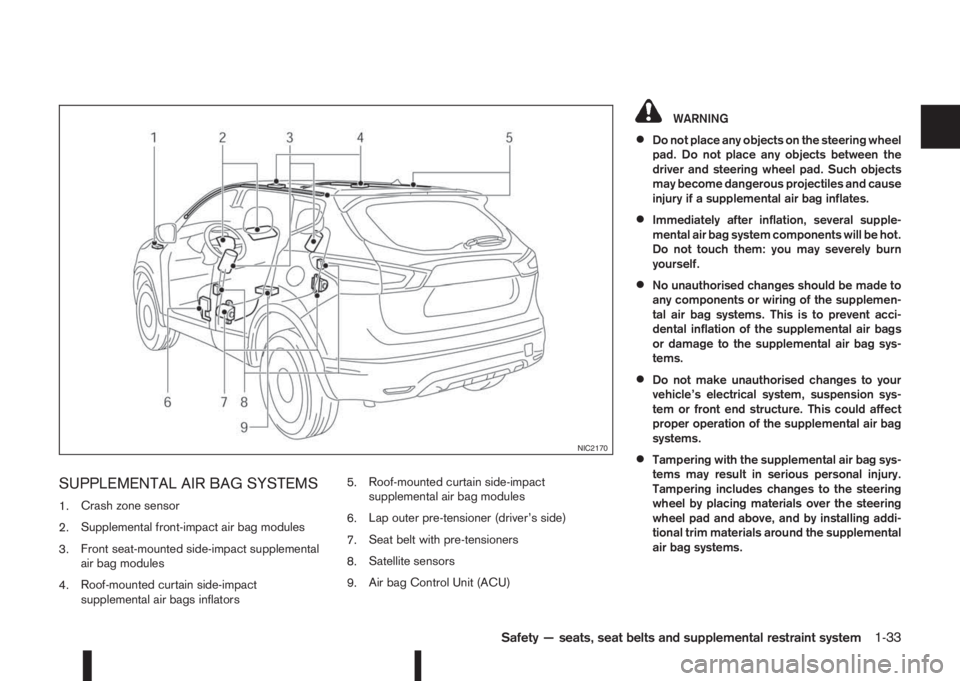
SUPPLEMENTAL AIR BAG SYSTEMS
1.Crash zone sensor
2.Supplemental front-impact air bag modules
3.Front seat-mounted side-impact supplemental
air bag modules
4.Roof-mounted curtain side-impact
supplemental air bags inflators5.Roof-mounted curtain side-impact
supplemental air bag modules
6.Lap outer pre-tensioner (driver’s side)
7.Seat belt with pre-tensioners
8.Satellite sensors
9.Air bag Control Unit (ACU)
WARNING
•Do not place any objects on the steering wheel
pad. Do not place any objects between the
driver and steering wheel pad. Such objects
may become dangerous projectiles and cause
injury if a supplemental air bag inflates.
•Immediately after inflation, several supple-
mental air bag system components will be hot.
Do not touch them: you may severely burn
yourself.
•No unauthorised changes should be made to
any components or wiring of the supplemen-
tal air bag systems. This is to prevent acci-
dental inflation of the supplemental air bags
or damage to the supplemental air bag sys-
tems.
•Do not make unauthorised changes to your
vehicle’s electrical system, suspension sys-
tem or front end structure. This could affect
proper operation of the supplemental air bag
systems.
•Tampering with the supplemental air bag sys-
tems may result in serious personal injury.
Tampering includes changes to the steering
wheel by placing materials over the steering
wheel pad and above, and by installing addi-
tional trim materials around the supplemental
air bag systems.NIC2170
Safety — seats, seat belts and supplemental restraint system1-33
Page 54 of 338
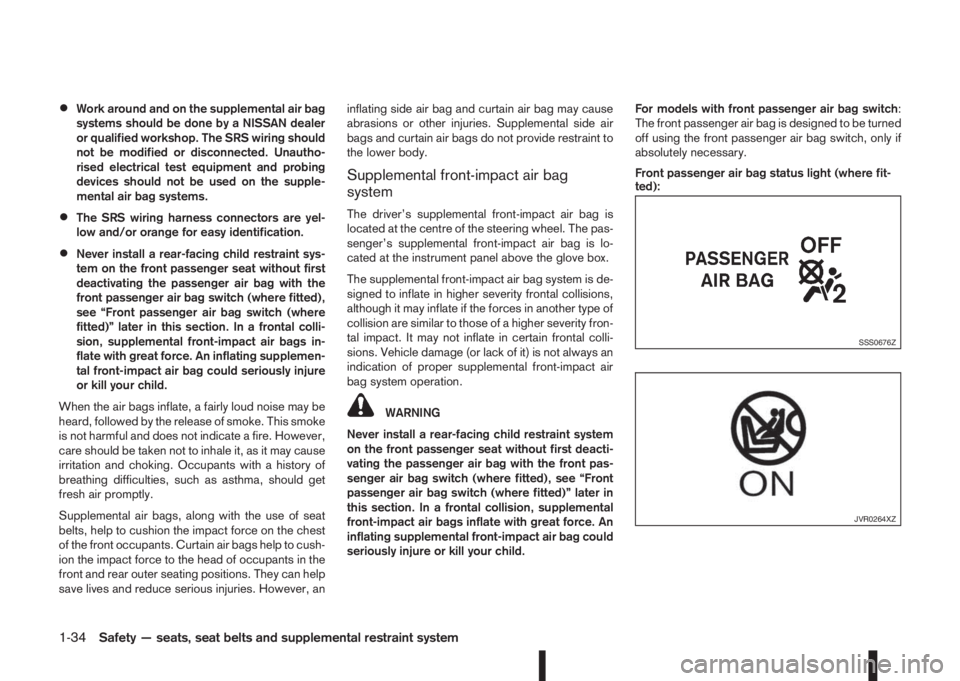
•Work around and on the supplemental air bag
systems should be done by a NISSAN dealer
or qualified workshop. The SRS wiring should
not be modified or disconnected. Unautho-
rised electrical test equipment and probing
devices should not be used on the supple-
mental air bag systems.
•The SRS wiring harness connectors are yel-
low and/or orange for easy identification.
•Never install a rear-facing child restraint sys-
tem on the front passenger seat without first
deactivating the passenger air bag with the
front passenger air bag switch (where fitted),
see “Front passenger air bag switch (where
fitted)” later in this section. In a frontal colli-
sion, supplemental front-impact air bags in-
flate with great force. An inflating supplemen-
tal front-impact air bag could seriously injure
or kill your child.
When the air bags inflate, a fairly loud noise may be
heard, followed by the release of smoke. This smoke
is not harmful and does not indicate a fire. However,
care should be taken not to inhale it, as it may cause
irritation and choking. Occupants with a history of
breathing difficulties, such as asthma, should get
fresh air promptly.
Supplemental air bags, along with the use of seat
belts, help to cushion the impact force on the chest
of the front occupants. Curtain air bags help to cush-
ion the impact force to the head of occupants in the
front and rear outer seating positions. They can help
save lives and reduce serious injuries. However, aninflating side air bag and curtain air bag may cause
abrasions or other injuries. Supplemental side air
bags and curtain air bags do not provide restraint to
the lower body.
Supplemental front-impact air bag
system
The driver’s supplemental front-impact air bag is
located at the centre of the steering wheel. The pas-
senger’s supplemental front-impact air bag is lo-
cated at the instrument panel above the glove box.
The supplemental front-impact air bag system is de-
signed to inflate in higher severity frontal collisions,
although it may inflate if the forces in another type of
collision are similar to those of a higher severity fron-
tal impact. It may not inflate in certain frontal colli-
sions. Vehicle damage (or lack of it) is not always an
indication of proper supplemental front-impact air
bag system operation.
WARNING
Never install a rear-facing child restraint system
on the front passenger seat without first deacti-
vating the passenger air bag with the front pas-
senger air bag switch (where fitted), see “Front
passenger air bag switch (where fitted)” later in
this section. In a frontal collision, supplemental
front-impact air bags inflate with great force. An
inflating supplemental front-impact air bag could
seriously injure or kill your child.For models with front passenger air bag switch:
The front passenger air bag is designed to be turned
off using the front passenger air bag switch, only if
absolutely necessary.
Front passenger air bag status light (where fit-
ted):
SSS0676Z
JVR0264XZ
1-34Safety — seats, seat belts and supplemental restraint system
Page 55 of 338
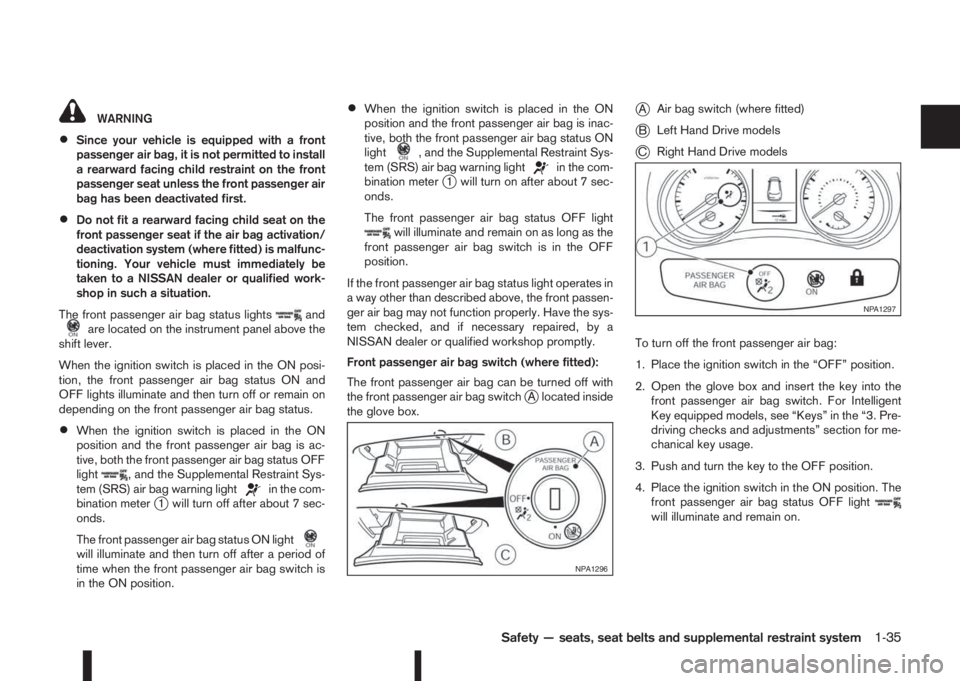
WARNING
•Since your vehicle is equipped with a front
passenger air bag, it is not permitted to install
a rearward facing child restraint on the front
passenger seat unless the front passenger air
bag has been deactivated first.
•Do not fit a rearward facing child seat on the
front passenger seat if the air bag activation/
deactivation system (where fitted) is malfunc-
tioning. Your vehicle must immediately be
taken to a NISSAN dealer or qualified work-
shop in such a situation.
The front passenger air bag status lights
andare located on the instrument panel above the
shift lever.
When the ignition switch is placed in the ON posi-
tion, the front passenger air bag status ON and
OFF lights illuminate and then turn off or remain on
depending on the front passenger air bag status.
•When the ignition switch is placed in the ON
position and the front passenger air bag is ac-
tive, both the front passenger air bag status OFF
light
, and the Supplemental Restraint Sys-
tem (SRS) air bag warning lightin the com-
bination meterj1 will turn off after about 7 sec-
onds.
The front passenger air bag status ON light
will illuminate and then turn off after a period of
time when the front passenger air bag switch is
in the ON position.
•When the ignition switch is placed in the ON
position and the front passenger air bag is inac-
tive, both the front passenger air bag status ON
light
, and the Supplemental Restraint Sys-
tem (SRS) air bag warning lightin the com-
bination meterj1 will turn on after about 7 sec-
onds.
The front passenger air bag status OFF light
will illuminate and remain on as long as the
front passenger air bag switch is in the OFF
position.
If the front passenger air bag status light operates in
a way other than described above, the front passen-
ger air bag may not function properly. Have the sys-
tem checked, and if necessary repaired, by a
NISSAN dealer or qualified workshop promptly.
Front passenger air bag switch (where fitted):
The front passenger air bag can be turned off with
the front passenger air bag switch
jA located inside
the glove box.
jAAir bag switch (where fitted)
jBLeft Hand Drive models
jCRight Hand Drive models
To turn off the front passenger air bag:
1. Place the ignition switch in the “OFF” position.
2. Open the glove box and insert the key into the
front passenger air bag switch. For Intelligent
Key equipped models, see “Keys” in the “3. Pre-
driving checks and adjustments” section for me-
chanical key usage.
3. Push and turn the key to the OFF position.
4. Place the ignition switch in the ON position. The
front passenger air bag status OFF light
will illuminate and remain on.
NPA1296
NPA1297
Safety — seats, seat belts and supplemental restraint system1-35
Page 56 of 338
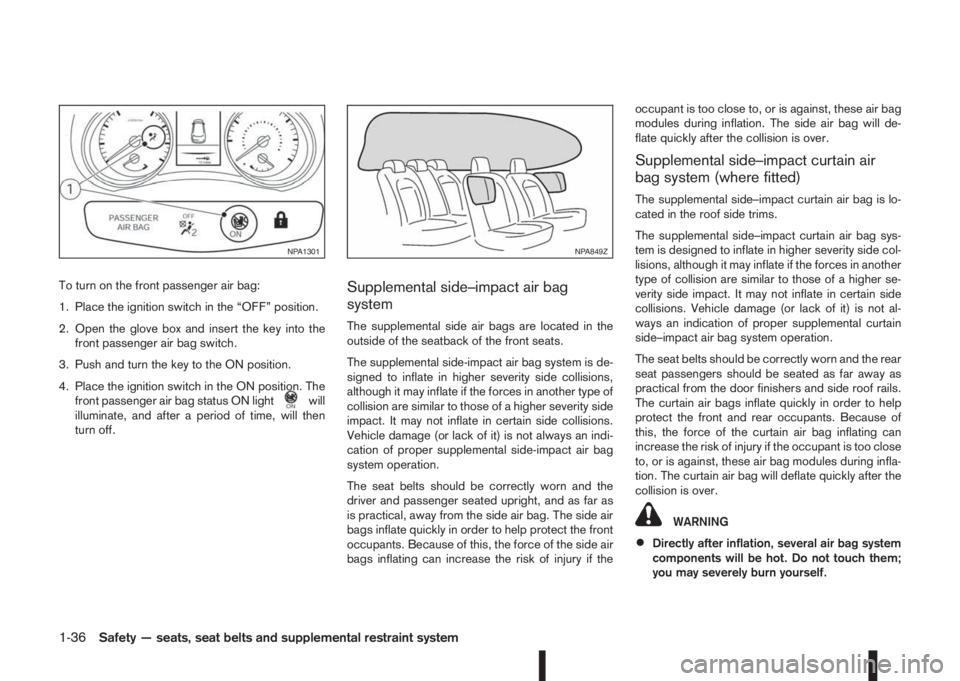
To turn on the front passenger air bag:
1. Place the ignition switch in the “OFF” position.
2. Open the glove box and insert the key into the
front passenger air bag switch.
3. Push and turn the key to the ON position.
4. Place the ignition switch in the ON position. The
front passenger air bag status ON light
will
illuminate, and after a period of time, will then
turn off.
Supplemental side–impact air bag
system
The supplemental side air bags are located in the
outside of the seatback of the front seats.
The supplemental side-impact air bag system is de-
signed to inflate in higher severity side collisions,
although it may inflate if the forces in another type of
collision are similar to those of a higher severity side
impact. It may not inflate in certain side collisions.
Vehicle damage (or lack of it) is not always an indi-
cation of proper supplemental side-impact air bag
system operation.
The seat belts should be correctly worn and the
driver and passenger seated upright, and as far as
is practical, away from the side air bag. The side air
bags inflate quickly in order to help protect the front
occupants. Because of this, the force of the side air
bags inflating can increase the risk of injury if theoccupant is too close to, or is against, these air bag
modules during inflation. The side air bag will de-
flate quickly after the collision is over.
Supplemental side–impact curtain air
bag system (where fitted)
The supplemental side–impact curtain air bag is lo-
cated in the roof side trims.
The supplemental side–impact curtain air bag sys-
tem is designed to inflate in higher severity side col-
lisions, although it may inflate if the forces in another
type of collision are similar to those of a higher se-
verity side impact. It may not inflate in certain side
collisions. Vehicle damage (or lack of it) is not al-
ways an indication of proper supplemental curtain
side–impact air bag system operation.
The seat belts should be correctly worn and the rear
seat passengers should be seated as far away as
practical from the door finishers and side roof rails.
The curtain air bags inflate quickly in order to help
protect the front and rear occupants. Because of
this, the force of the curtain air bag inflating can
increase the risk of injury if the occupant is too close
to, or is against, these air bag modules during infla-
tion. The curtain air bag will deflate quickly after the
collision is over.
WARNING
•Directly after inflation, several air bag system
components will be hot. Do not touch them;
you may severely burn yourself.
NPA1301NPA849Z
1-36Safety — seats, seat belts and supplemental restraint system
Page 57 of 338
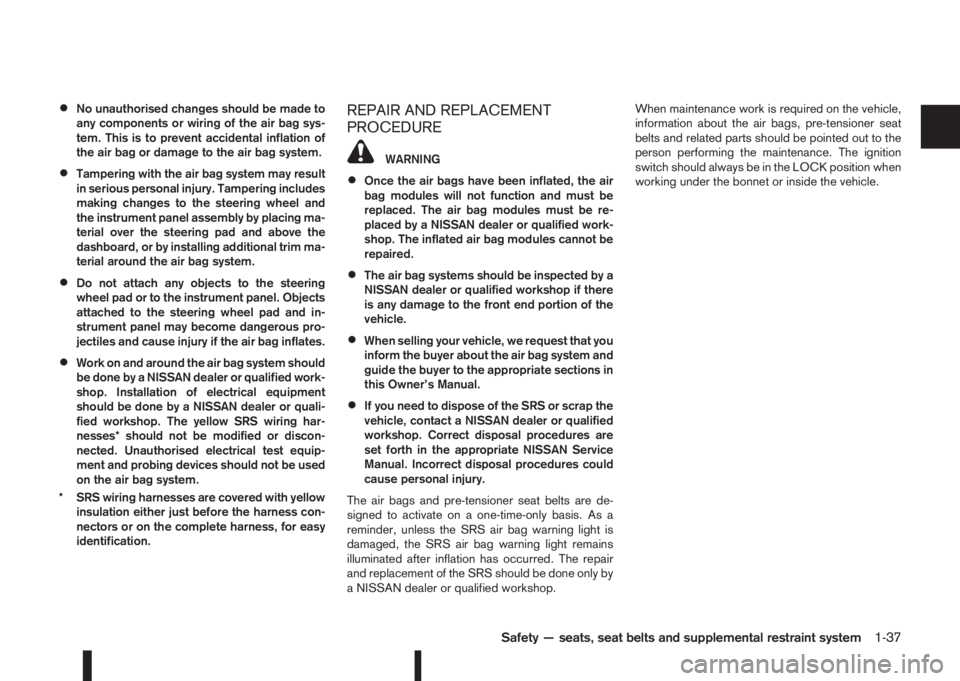
•No unauthorised changes should be made to
any components or wiring of the air bag sys-
tem. This is to prevent accidental inflation of
the air bag or damage to the air bag system.
•Tampering with the air bag system may result
in serious personal injury. Tampering includes
making changes to the steering wheel and
the instrument panel assembly by placing ma-
terial over the steering pad and above the
dashboard, or by installing additional trim ma-
terial around the air bag system.
•Do not attach any objects to the steering
wheel pad or to the instrument panel. Objects
attached to the steering wheel pad and in-
strument panel may become dangerous pro-
jectiles and cause injury if the air bag inflates.
•Work on and around the air bag system should
be done by a NISSAN dealer or qualified work-
shop. Installation of electrical equipment
should be done by a NISSAN dealer or quali-
fied workshop. The yellow SRS wiring har-
nesses* should not be modified or discon-
nected. Unauthorised electrical test equip-
ment and probing devices should not be used
on the air bag system.
* SRS wiring harnesses are covered with yellow
insulation either just before the harness con-
nectors or on the complete harness, for easy
identification.
REPAIR AND REPLACEMENT
PROCEDURE
WARNING
•Once the air bags have been inflated, the air
bag modules will not function and must be
replaced. The air bag modules must be re-
placed by a NISSAN dealer or qualified work-
shop. The inflated air bag modules cannot be
repaired.
•The air bag systems should be inspected by a
NISSAN dealer or qualified workshop if there
is any damage to the front end portion of the
vehicle.
•When selling your vehicle, we request that you
inform the buyer about the air bag system and
guide the buyer to the appropriate sections in
this Owner’s Manual.
•If you need to dispose of the SRS or scrap the
vehicle, contact a NISSAN dealer or qualified
workshop. Correct disposal procedures are
set forth in the appropriate NISSAN Service
Manual. Incorrect disposal procedures could
cause personal injury.
The air bags and pre-tensioner seat belts are de-
signed to activate on a one-time-only basis. As a
reminder, unless the SRS air bag warning light is
damaged, the SRS air bag warning light remains
illuminated after inflation has occurred. The repair
and replacement of the SRS should be done only by
a NISSAN dealer or qualified workshop.When maintenance work is required on the vehicle,
information about the air bags, pre-tensioner seat
belts and related parts should be pointed out to the
person performing the maintenance. The ignition
switch should always be in the LOCK position when
working under the bonnet or inside the vehicle.
Safety — seats, seat belts and supplemental restraint system1-37
Page 58 of 338
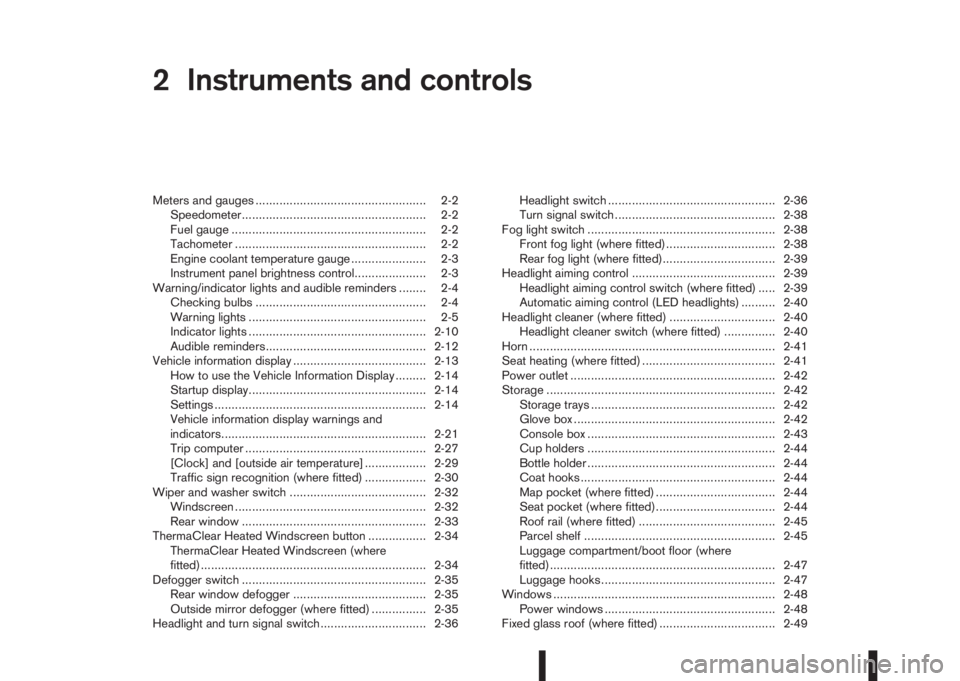
2Instruments and controlsInstruments and controls
Meters and gauges .................................................. 2-2
Speedometer...................................................... 2-2
Fuel gauge ......................................................... 2-2
Tachometer ........................................................ 2-2
Engine coolant temperature gauge ...................... 2-3
Instrument panel brightness control..................... 2-3
Warning/indicator lights and audible reminders ........ 2-4
Checking bulbs .................................................. 2-4
Warning lights .................................................... 2-5
Indicator lights .................................................... 2-10
Audible reminders............................................... 2-12
Vehicle information display ....................................... 2-13
How to use the Vehicle Information Display ......... 2-14
Startup display.................................................... 2-14
Settings .............................................................. 2-14
Vehicle information display warnings and
indicators............................................................ 2-21
Trip computer ..................................................... 2-27
[Clock] and [outside air temperature] .................. 2-29
Traffic sign recognition (where fitted) .................. 2-30
Wiper and washer switch ........................................ 2-32
Windscreen ........................................................ 2-32
Rear window ...................................................... 2-33
ThermaClear Heated Windscreen button ................. 2-34
ThermaClear Heated Windscreen (where
fitted).................................................................. 2-34
Defogger switch ...................................................... 2-35
Rear window defogger ....................................... 2-35
Outside mirror defogger (where fitted) ................ 2-35
Headlight and turn signal switch............................... 2-36Headlight switch ................................................. 2-36
Turn signal switch ............................................... 2-38
Fog light switch ....................................................... 2-38
Front fog light (where fitted)................................ 2-38
Rear fog light (where fitted)................................. 2-39
Headlight aiming control .......................................... 2-39
Headlight aiming control switch (where fitted) ..... 2-39
Automatic aiming control (LED headlights) .......... 2-40
Headlight cleaner (where fitted) ............................... 2-40
Headlight cleaner switch (where fitted) ............... 2-40
Horn ........................................................................ 2-41
Seat heating (where fitted) ....................................... 2-41
Power outlet ............................................................ 2-42
Storage ................................................................... 2-42
Storage trays ...................................................... 2-42
Glove box ........................................................... 2-42
Console box ....................................................... 2-43
Cup holders ....................................................... 2-44
Bottle holder ....................................................... 2-44
Coat hooks ......................................................... 2-44
Map pocket (where fitted) ................................... 2-44
Seat pocket (where fitted)................................... 2-44
Roof rail (where fitted) ........................................ 2-45
Parcel shelf ........................................................ 2-45
Luggage compartment/boot floor (where
fitted).................................................................. 2-47
Luggage hooks ................................................... 2-47
Windows ................................................................. 2-48
Power windows .................................................. 2-48
Fixed glass roof (where fitted) .................................. 2-49
Page 59 of 338
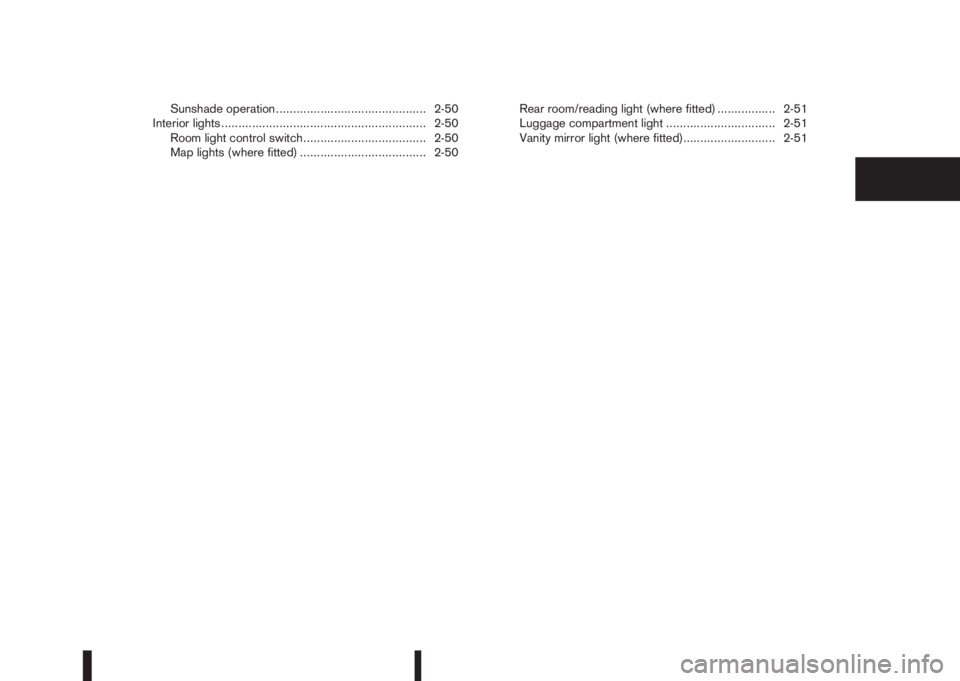
Sunshade operation ............................................ 2-50
Interior lights ............................................................ 2-50
Room light control switch.................................... 2-50
Map lights (where fitted) ..................................... 2-50Rear room/reading light (where fitted) ................. 2-51
Luggage compartment light ................................ 2-51
Vanity mirror light (where fitted)........................... 2-51
Page 60 of 338
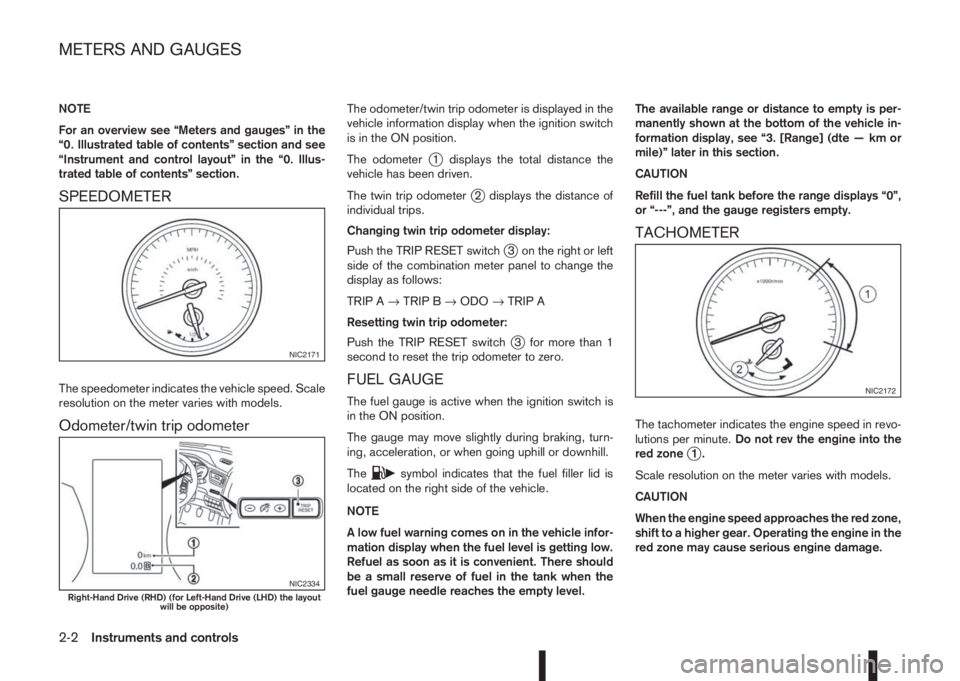
NOTE
For an overview see “Meters and gauges” in the
“0. Illustrated table of contents” section and see
“Instrument and control layout” in the “0. Illus-
trated table of contents” section.
SPEEDOMETER
The speedometer indicates the vehicle speed. Scale
resolution on the meter varies with models.
Odometer/twin trip odometer
The odometer/twin trip odometer is displayed in the
vehicle information display when the ignition switch
is in the ON position.
The odometer
j1 displays the total distance the
vehicle has been driven.
The twin trip odometer
j2 displays the distance of
individual trips.
Changing twin trip odometer display:
Push the TRIP RESET switch
j3 on the right or left
side of the combination meter panel to change the
display as follows:
TRIP A→TRIP B→ODO→TRIP A
Resetting twin trip odometer:
Push the TRIP RESET switch
j3 for more than 1
second to reset the trip odometer to zero.
FUEL GAUGE
The fuel gauge is active when the ignition switch is
in the ON position.
The gauge may move slightly during braking, turn-
ing, acceleration, or when going uphill or downhill.
The
csymbol indicates that the fuel filler lid is
located on the right side of the vehicle.
NOTE
A low fuel warning comes on in the vehicle infor-
mation display when the fuel level is getting low.
Refuel as soon as it is convenient. There should
be a small reserve of fuel in the tank when the
fuel gauge needle reaches the empty level.The available range or distance to empty is per-
manently shown at the bottom of the vehicle in-
formation display, see “3. [Range] (dte — km or
mile)” later in this section.
CAUTION
Refill the fuel tank before the range displays “0”,
or “---”, and the gauge registers empty.
TACHOMETER
The tachometer indicates the engine speed in revo-
lutions per minute.Do not rev the engine into the
red zone
j1.
Scale resolution on the meter varies with models.
CAUTION
When the engine speed approaches the red zone,
shift to a higher gear. Operating the engine in the
red zone may cause serious engine damage.
NIC2171
NIC2334Right-Hand Drive (RHD) (for Left-Hand Drive (LHD) the layout
will be opposite)
NIC2172
METERS AND GAUGES
2-2Instruments and controls